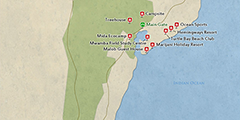- You are here:
- Home
- Countries & Parks
- Kenya Parks
- Arabuko Sokoke Forest Reserve
Overview – Arabuko Sokoke FR

Philip is a renowned Africa expert and author of many guidebooks to African destinations, including the DK Eyewitness Guide to Kenya.
Philip is an expert for SafariBookings and author of the DK Eyewitness Guide to Kenya.
Philip is the author of the DK Eyewitness Guide to Kenya.
Arabuko Sokoke Forest Reserve comprises the largest remaining tract of coastal forest in East Africa. It is best known as a bird-watching destination, thanks to the presence of several rare endemic and near-endemic species. However, the reserve also harbors a long list of mammals including elephant, buffalo and several localized forest specials. An extension of the main forest is protected in Gede Ruins National Monument, a ruined medieval Swahili city complete with several old mosques.


Pros & Cons
- One of East Africa’s most important coastal forests
- Rare forest wildlife including several endemics
- Large variety of butterflies and frogs
- The reserve is little visited and never gets busy
- More than 100km/60mi of roads and 4x4 tracks
- Guided walks and hikes available
- Stunning scenery
- Excellent birding with forest specials and endemics
- Easy day trip from the popular coastal resorts of Watamu or Malindi
- No accommodations available, only basic camping
- Seeing the endemic mammals and birds requires patience and/or luck
- Few big safari animals
Arabuko Sokoke FR Safari Reviews
Wildlife
Arabuko Sokoke is home to a variety of mammals, but there are few guarantees when it comes to spotting them. Around 300 elephants are resident in the reserve, and they are quite often seen drinking at Arabuko Swamp toward sunset. Buffalo are also present, but encounters are more random. Troops of yellow baboon are a common sight. Of greater interest to wildlife enthusiasts are the endemic Aders’s duiker, Sokoke dog mongoose and golden-rumped elephant shrew.
Scenery
The reserve’s main habitat is coastal dry forest. The ecosystem comprises three forest types: mixed forest, miombo woodland (lovely for walking in with its open canopy) and cynometra (tropical forest). Each is home to different animal species. There are several forest-fringed ponds with water lilies along the trails, while the Arabuko Swamp is a favored haunt of elephant. The Nyari viewpoint offers spectacular views over the forest canopy to the Indian Ocean.
Activities
Guided nature and bird walks can be arranged on the spot at Gede Gate. Game drives are also possible, and while taking a guide isn’t mandatory, it will improve your chances of spotting forest wildlife. If you want to see elephants, drive out to Arabuko Swamp (6km/4mi from Gede Gate) in the late afternoon. Just outside the reserve, Gede Ruins National Monument is a magical place to spend a couple of hours exploring the mysterious jungle-bound ruins of a medieval Swahili port.
Weather & Climate
Arabuko Sokoke doubles up on its dry and wet periods. There are two drier seasons: a hotter one at the start of the year (December to March) and a cooler one midyear (June to September). In between are the long rains of April and May, when storms are common, and the short rains of October and November.
Best Time To Visit
You can visit Arabuko Sokoke year-round. The rain will test your stamina and perseverance on forest hikes in the wetter months, but you’ll have lots more birds, as well as frogs, for company. Alternatively, visit in the drier months, when the sunshine makes getting around much more pleasant.
Want To Visit Arabuko Sokoke FR?
Arabuko Sokoke FR Safari Reviews
- Expert Rating
- Wildlife
- Scenery
- Bush Vibe
- Birding
- User Rating
- Wildlife
- Scenery
- Bush Vibe
- Birding
Most Helpful Expert Review

Stuart is a travel writer and author of numerous Lonely Planet guidebooks, including 'Kenya', 'Rwanda' and 'Tanzania'.
Elephant Shrews and ghosts
You don’t come to Arabuko Sokoke expecting to see the Big Five, but this, one of the last, large tracts of typical coastal forest left on the Kenyan coastline, makes for a brilliant half-day trip from the nearby beach resorts of Malindi...
Latest User Review
 BE
BE
Very happy birding
This was my second time in Arabuko Sokoke forest. I especially went there for the owl's. My guide was very good, knew all the birds, made sounds to lure them and overall it was one of my better birdwalks in Kenya. ( a lot) I did book a...


 Kenya Parks
Kenya Parks

